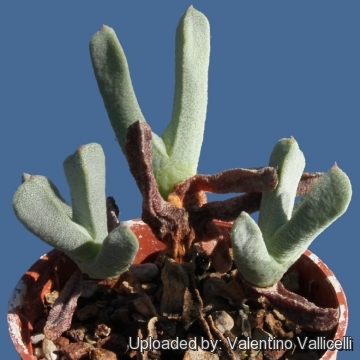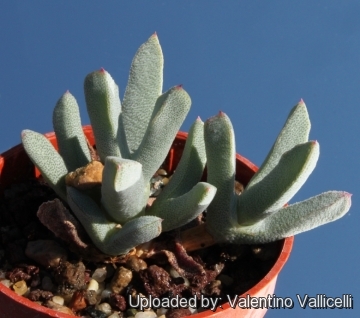




Your support is critical to our success.
Piante Grasse 15(4, Suppl.): 86. 1996 [1995 publ. 1996]
Family: AIZOACEAE

Origin and Habitat: Northern Cape (District Namaqualand), Republic of South Africa.
Altitude: Around 1100 metres above sea level.
habitat: Odontophorus pusillusSN|18093]]SN|18093]] grows in quartz gravel patch mainly on the upper slopes of larger inselbergs. Annual precipitation is approximately 100 mm, mostly in winter.
Synonyms:
- Odontophorus pusillus S.A.Hammer
Description: Odontophorus pusillusSN|18094]]SN|18093]] is a small succulent shrub up to 8 cm hight, and 8 cm with margins of leaves often toothed apically.
Stem: Ramified, with several almost equal, erect branches, the primary shoot being longer than the lateral ones, a rare conditions in the family. Internodes corky and spongy, shining ochre resembleing those of Odontophorus angustifoliusSN|18093]]SN|18094]].
Leaves: 22-25 mm long, 6-8 mm broad, trigonous, margins subapically with a tooth on each side rendering the tip of the upper leaf surface triangular, keel with several very tiny teeth if not serrulate, epidermis smooth and papillate, geyish-green or bluish-green.
Flowers: Solitary and terminal, daisy-like, petals yellow, basally white, acuminate (diameter: 25 mm).
Fruits: The fruit is a 10-11-chambered capsule base semi-globose, top almost flat.
Seeds: Dark brown, 0,75 x 0,44 mm broad.
Bibliography: Major references and further lectures
1) Heidrun E. K. Hartmann “Aizoaceae F – Z” Springer, 2002
2) Hartmann. H. “Monographie der Gattung Odontophorus” Botantsche Jahrbucher 97: 161-225 (1976)
3) Jacobsen. “Handbook of succulent plants” 1328 (1960)
4) James Cullen, Sabina G. Knees, H. Suzanne Cubey “The European Garden Flora Flowering Plants: A Manual for the Identification of Plants Cultivated in Europe, Both Out-of-Doors and Under Glass - Casuarinaceae to Aristolochiaceae” Cambridge University Press, 11/ago/2011

- Locality: Quachous (MG 1786.23) Photo by: Valentino Vallicelli

Odontophorus pusillus Photo by: Valentino Vallicelli
Cultivation and Propagation: The Odontophorus are easy to grow. Odontophorus pusillus seems to prefer a fairly dry rest in summer but grows whenever watered. It is easy to grow.
Soil: Requires good drainage as it it is prone to root rot. It can grows outdoor in sunny, dry, rock crevices (protection against winter wet is required) It can also be cultivated in alpine house, in poor, drained soil.
Fertilization: Feed it once during the growing season with a fertilizer specifically formulated for cactus succulents (poor in nitrogen), including all micro nutrients and trace elements diluted to ½ the strength recommended on the label. It thrives in poor soils and need a limited supplies of fertilizer to avoid the plants developing excess vegetation, which is easily attacked by fungal diseases.
Watering: They are not at all delicate and can take some water year-round. Water minimally in winter, only when the plant starts shrivelling, water more abundantly when they are growing in the autumn and spring, but let the soil dry between soaking. An occasional summer soaking is wise. If grown in a container, bottom watering by immersing the container is recommended. It must have very dry atmosphere.
Light: It needs a bright sunny or light shade exposure in winter, but keep cool and partially shaded in summer.
Hardiness: It prefer a very bright situation and require a minimum temperature 0°C (But will take frost and is hardy down to -12° C or less for short periods if is in dry soil ). USDA zones (8-)9-11. The earlier in the year they are planted, the better the chances for winter survival. True with many of the Mesembryanthemaceae.
Uses: They are hardy and they look fine in a cold greenhouse, frame, in containers or outdoor in a rockery.
Pests & diseases: They may be attractive to a variety of insects, but plants in good condition should be nearly pest-free, particularly if they are grown in a mineral potting-mix, with good exposure and ventilation. Nonetheless, there are several pests to watch for:
- Red spiders: they may be effectively rubbed up by misting the vulnerable plants every day.
- Mealy bugs: Occasianlly mealy bugs develop aerial into the new leaves and flowers with disfiguring results, but the worst types develop underground on the roots and are invisible except by their effects.
- Sciara Flies: Sciara Flies are one of the major problems for seedlings. It is a good practice to mulch your seedlings with a layer of grit, which will strongly discourage the flies.
- Scales, thrips and aphids: This insects are rarely a problem.
It is wise to treat your whole collection with a systemic insecticide twice a year in spring and autumn.
- Rot: Rot it is only a minor problem with mesembs if the plants are watered and “aired” correctly. If they are not, fungicides won't help all that much.
Propagation: Seed in spring or (or rarely) cuttings. To make a cutting twist off a branch with at least a part of roots and permit it to dry out a couple of days, lay it on the soil and insert the stem end partially into the soil. Try to keep the cutting somewhat upright so that the roots are able to grow downward.
| Your Actions | |
|---|---|
| Back to Odontophorus index | |
| Back to Aizoaceae index | |
 |
Back to Succulents Encyclopedia index |
Privacy stantement - Terms and conditions - How to cite - About us - Feedback - Donate



